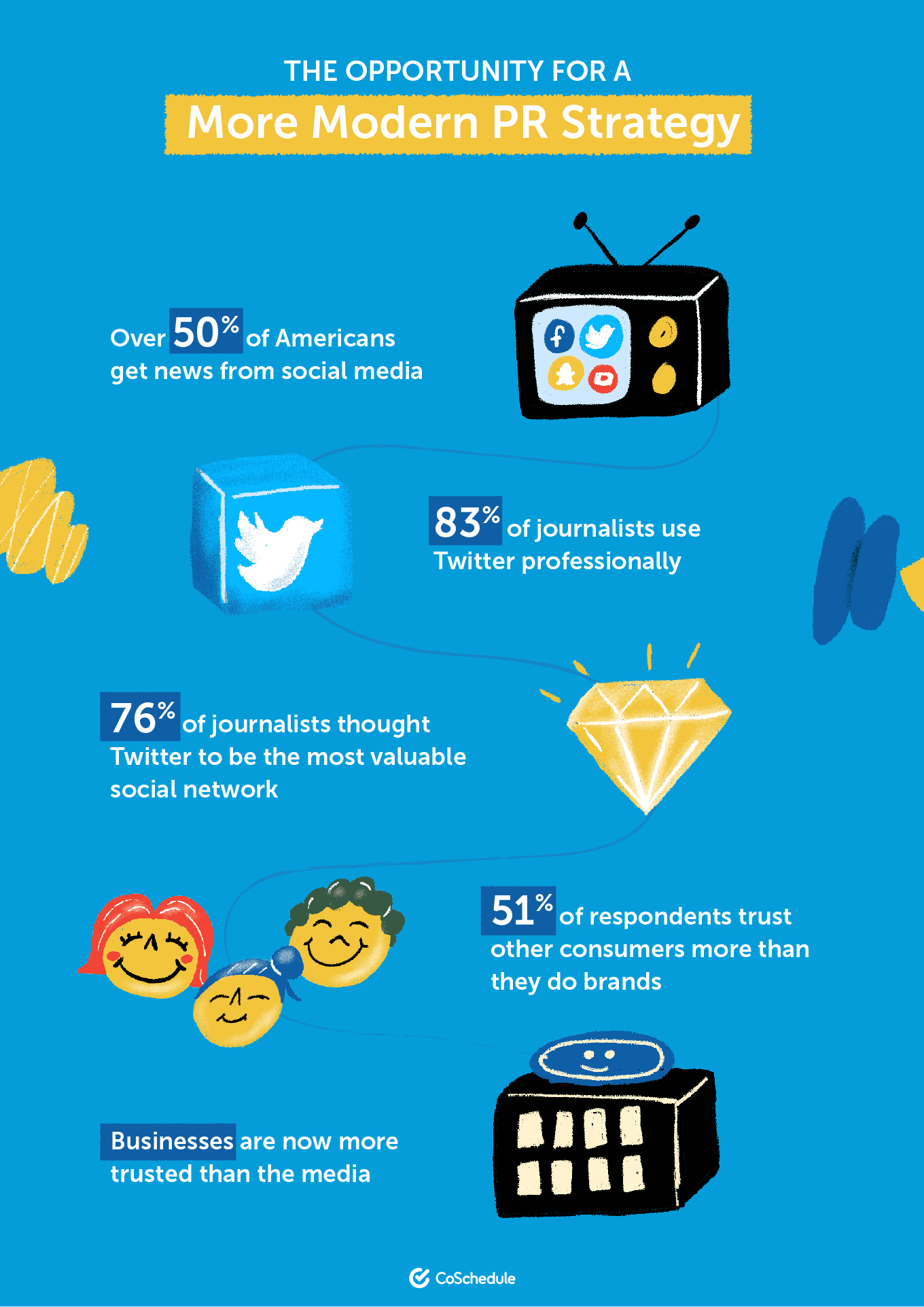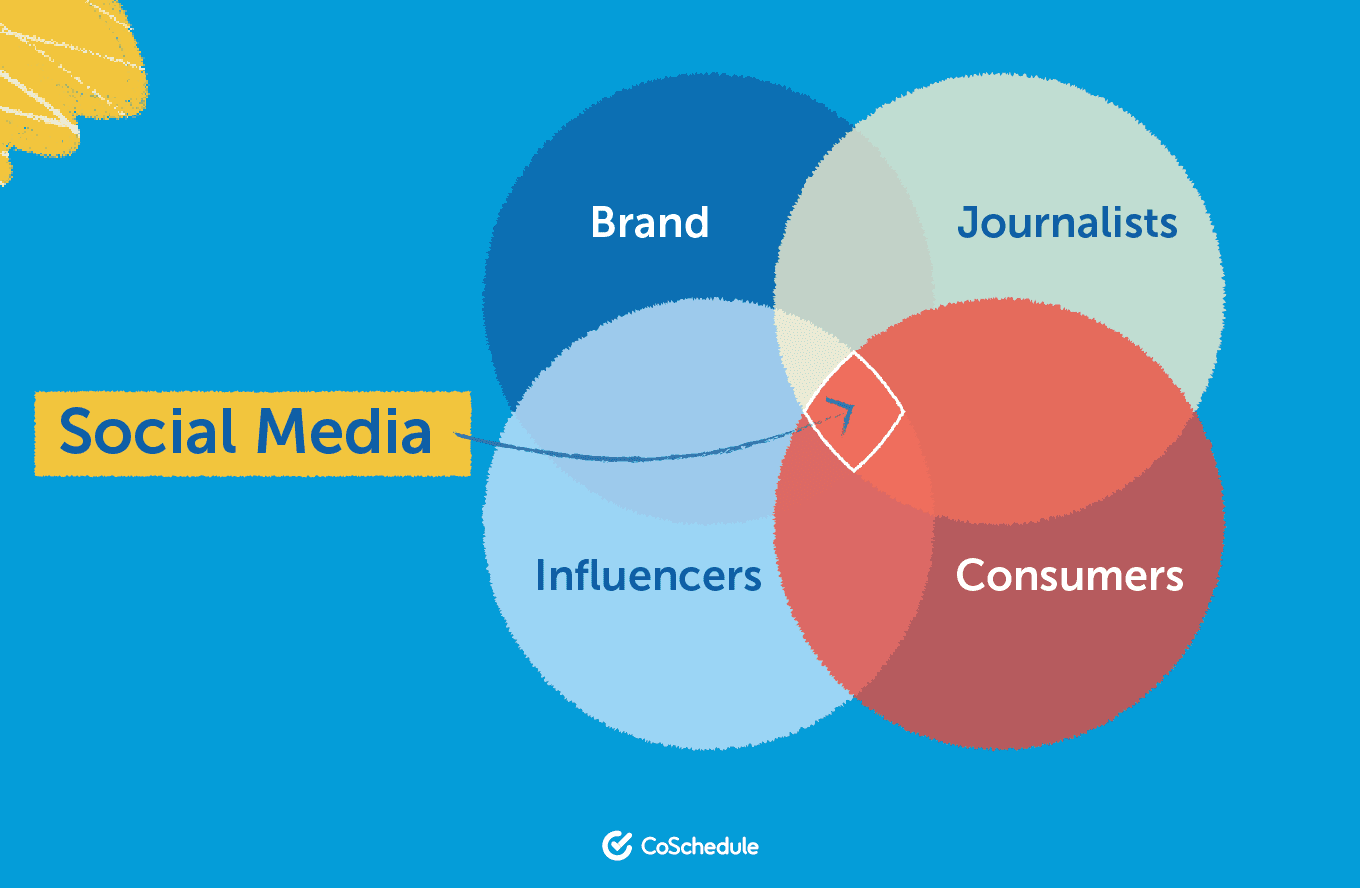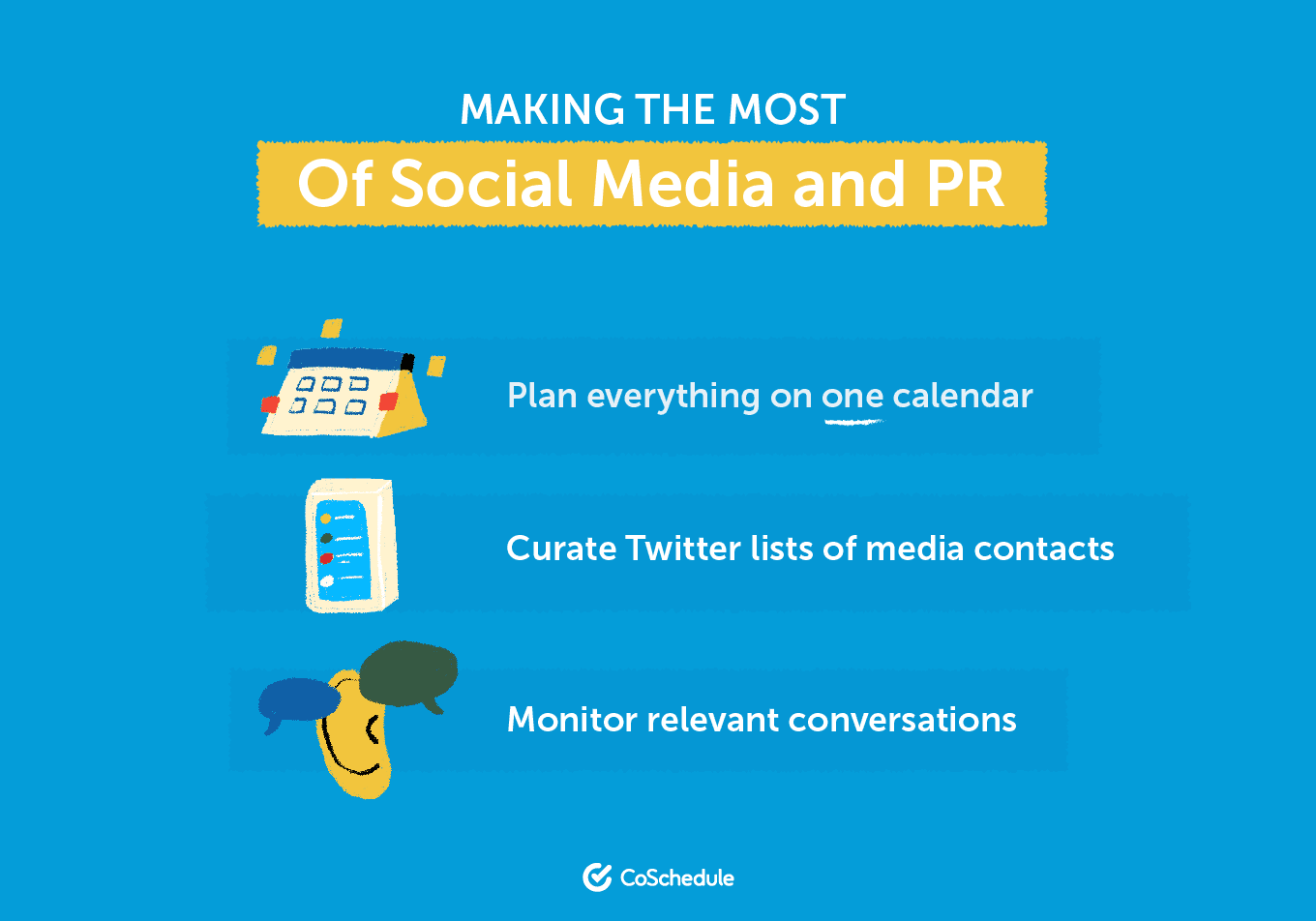Like any other industry, technology has thrown communications through a loop the past few decades. The options we have for reaching the public and our customers have never been greater or more direct.
In the past, public relations was largely about managing relationships and communication with the media, including outlets like print, TV, radio, and more. They were a necessary go-between for almost any brand communication.
Now though, in addition to using the media as a communications tool to reach the public, we can go straight to it ourselves. The internet has flattened the levels of communication required and given people the ability to connect directly.
So instead of just “relating” to the media, modern public relations has the opportunity to supplement that with going straight to the people who care about your message.
This intimidates some marketers and PR pros. And with a different corporate social media gaffe going viral each week, it’s understandable.
But when you build a strong strategy for integrating your PR and social media, that won’t be you. Instead, you’re more likely to be one of the many, many success stories.
They’re just not as entertaining for social media users to make jokes about.
So, how can you make sure your strategy is strong enough? Let’s talk about it.
[Tweet “Better Together: How to Integrate Social Media and PR via @CoSchedule”]
But First, Claim Your PR Calendar Templates
Looking for a way to manage all the projects in your PR strategy without dropping the ball? Try our free PR calendar templates to help you plan and juggle your different campaigns, pitches, relationships, and more.
[content_upgrade_shortcode]
Table of Contents
- Stats About PR, Public Trust, and Social Media
- Ideas for Using Social Media for PR
- Tips for Bringing Social Media and PR Together
Stats About PR, Public Trust, and Social Media
If you’re not yet convinced that leveraging social media is an essential responsibility of public relations, let the numbers speak for themselves.
A few in particular are noteworthy:

- In 2019, Pew Research Center found that over 50% of Americans get news from social media. Because that was already an increasing trend and the pandemic has further sped up news cycles, it’s likely even higher now. This means that social networks serve as media outlets for your customers audience, even if the networks don’t see it that way.
- MuckRack found in 2019 that 83% of journalists use Twitter professionally, with other networks increasing in importance. So even without the ability to go straight to your audience, social media is a valuable tool for connecting with journalists, a vital PR activity.
- In 2021, they also found that 76% of journalists thought Twitter to be the most valuable social network, with 16% of them using it as their first news source. With so many journalists expressly going to Twitter with news, reporting, and stories in mind, you can get in front of them at the exact moment they’re looking for their next story pitch.
- A survey from Olapic and Cite Research found that 51% of respondents trust other consumers more than they do brands. This means that having the recommendation of a customer’s peers or favorite influencers carries more weight than more traditional trust signals.
- The 2021 Edelman Trust Barometer found that while trust in information is at an all time low. With 61% and 51% global trust levels respectively, this highlights the opportunity in being able to use social media to go directly to your audience, instead of going through the media.
[Tweet “In 2021, MuckRack found that 76% of journalists thought Twitter to be the most valuable social network, with 16% of them using it as their first news source. via @CoSchedule”]
In summary, consumers trust traditional media less, although it’s still a huge part of their lives. And in addition to media, they’re relying on influencers more, making both crucial for PR and marketing teams to cultivate relationships with.
Basically, social media lets you talk to journalists, influencers, and consumers all in the same place.

It’s the simplest, most straightforward way to reach all the audiences you need to.
Efficiency, for the win!
Ideas for Using Social Media for PR
So, you’re ready to make more space in your PR toolkit for social media to play a bigger part. What exactly can you use it for?
Social media can play such a bigger part than a distribution vehicle for company announcements and marketing content.
(Although it’s still great for that, too! We’ll get to how later in the post.)
Here are a few of the easiest ways to start using PR and social media together:

Know Which Topics are Trending
PR requires keeping a keen eye on public opinion, of your brand specifically as well as your industry and culture in general. And that’s never been easier to monitor than with social media, which collects so many public opinions in one (often searchable) place.
Take advantage of how much you can learn about your audience and industry by simply listening.
Pay attention to what people are talking about, both good and bad, in the space your company operates in. Also note what unrelated topics related contacts are interested in.
This can be as easy as simply using social media yourself, as ways to keep up with trends are literally baked into several of the native platforms.
Take, for example, Twitter’s Trending Topics. Through your account’s settings, you can customize it to display trends based on your region or based on your activity on Twitter.
Their Explore page is another example of how trends are baked into the network itself. You can also select specific topics to follow through this page, which makes getting trending industry updates easy.
For more advanced or fine-tuned monitoring, there are social media monitoring tools like Mention. They let you watch for specific keywords or phrases that signal a conversation you want to pay attention to, conversations happening around specific URLs, and more.
Strategic monitoring can turn the seemingly endless stream of social updates on your network feeds into organized lists of the highlights you need.
Find and Contact Journalists in a Given Niche Using Twitter
Like we mentioned earlier, Twitter is the social network journalists rely on the most. They go there specifically in “work mode,” looking for story and pitch ideas, sources, and more. This makes it one of the best places to start building relationships with the journalists that cover your industry.
Media relations on Twitter is less about pitching journalists and more about the relationships required for pitches to succeed. By starting a relationship with a journalist on Twitter before you have a specific pitch to send them, you can make it so that they recognize and prioritize your name when your pitch lands in their email inbox.
Ways to build media relationships include:
- Supporting their work by sharing their stories
- Replying to their content and engage in friendly-but-professional conversation to build rapport
- Helping them in other ways without expecting immediate return
Plus, when you have a good relationship with journalists, they might think of you for stories or coverage without you even needing to pitch them.
[Tweet “Media relations on Twitter is less about pitching journalists and more about the relationships required for pitches to succeed. via @CoSchedule”]
Get a Finger on the Pulse of Conversation
In addition to using social media to understand the trending topics people are talking about, the newsworthy and viral moment, it’s also great for understanding wider culture in ways that are useful to multiple aspects of your PR and marketing. In short, it helps your team, and therefore your brand, stay relevant.
For example, even if you don’t use memes in your own marketing, you should still know what the most popular ones are. If only for the reason of avoiding an accidental meme where you don’t intend one, for example in a serious message.
It comes down to understanding how your customers and wider audience communicates and letting that shape your pitch and campaign angles. And it’s easiest to do with social media.
Some cultural and conversational trends to pay attention to include:
- Patterns in trending topics (like metatrends, important issues, and interests)
- Popular memes and meme formats
- Common language and slang trends
And since this is part of monitoring, it’s something that can be made easier with a monitoring tool to help filter the firehose of social content.
Build Relationships With Other Companies
Journalists aren’t the only important contacts hanging out on social media, of course. So in addition to using it to lay the groundwork for media relationships, you can do the same for collaborative relationships with other companies.
Whether you see the opportunity for a content collaboration, a joint promotion, or a product partnership, there’s opportunity to lay the groundwork on social media.
Simply support adjacent brands and organizations that serve similar purposes or audiences to yours. Engage with their tweets and other social posts. Have conversation. One industry you see doing this a lot is food brands, so follow them for inspiration if it won’t make you too hungry.
Connect With Influencers In Your Niche
You can also add influencers to the growing list of important contacts you can build relationships with on social media. I’m telling you, efficiency wins here.
Whether or not you run official influencer marketing projects at your company, it’s always a good idea to keep an eye on the top influencers in your industry. They’re often drivers and early adopters of the trends you should be watching.
Plus, there might be organic opportunities for conversation or other engagement without a formal partnership that can arise from following and interacting with them.
Share Your Company’s News and Story
A great thing about social media is that it allows you to tell the same brand story that can be found elsewhere in the media, in new and more engaging ways. It gives you the chance to tell your story and reinforce your brand values and message in ways that can’t always be found in traditional media opportunities.
For example, companies can jump into trends and memes and participate themselves in ways that both support the brand and have fun with your audience. Consider how the “how it started, how it’s going” meme is the perfect opportunity to contrast your brand’s beginnings and evolution. Throwback Thursday is another way to highlight your story. Twitter threads are another tool that offer a new storytelling format.
Plus, remember how often journalists go to social media looking for story ideas, or even to source people to include in their content. Participating in those trends and sharing your story on social media is another way to get their attention and potentially get covered in other media.
Controlling Crisis Management When the Worst Happens
The final way to use social media in your PR strategy is as a crisis management tool. No one enjoys thinking about worst case scenarios, but the past year has certainly taught us the importance of doing so in order to prepare.
In a crisis, PR or otherwise, social media is usually the most direct and real-time way to reach your customers and any other interested audience. It also makes it easy for journalists and other media covering the crisis to find the most up-to-date and accurate information from your brand.
When the situation calls for making immediacy and accuracy of information the highest priority, social media is the easiest way to communicate with multiple audiences simply and quickly.
Tips for Bringing Social Media and PR Together
If you’re ready to integrate social media further into your company’s PR strategy, first of all, fantastic! You won’t regret it.
Second of all, here are a few tips to keep in mind:

Plan PR and Social Activities on One Calendar
To make sure all the different branches of your marketing and communications are aligned and take each other into consideration, combine all of your activities into one calendar.
Whichever tool you choose to manage, say, your social media calendar, should also be where you plan out your PR calendar and marketing campaign calendar. In reality, they’re all connected. So they should be connected in your planning and project management as well.
We go over different options for managing that calendar here, and of course recommend trying CoSchedule for planning, managing, and publishing your campaigns from one place.
Curate Twitter Lists of Media Contacts
Once you’ve got planning under control, you can start getting your social media contacts list in order.
The first thing you’ll want to do is create Twitter lists of journalists, influencers, and other media you want to build up relationships with. You can use a tool like TwitListManager to make this easy. Then go to a social media dashboard or Twitter client like TweetDeck, where you can add streams for those Twitter lists in an easy-to-browse dashboard.
Follow Industry Conversations
Finally, in addition to monitoring specific media contacts through Twitter lists, use a monitoring tool or saved searches to follow industry conversations including key words and phrases.
Being able to monitor and jump into conversations already happening on these platforms allow you to engage your audience, reinforce your message, and further your brand without running your own campaign or publishing your own marketing content.
This adds a layer of consistency to your communications that makes it easier to stay top of mind with the right people even if you don’t have anything traditionally newsworthy to share.
Get Social with Your PR
Public relations has always been about managing different relationships at its core. In the past, you managed one relationship with the media, who then communicated to your audience. But with social media, you have the opportunity to talk to and engage both at the same time, and more.
Making the most of this requires a well planned strategy and calendar, so start working on yours.
The post Better Together: How to Integrate Social Media and PR appeared first on CoSchedule Blog.


